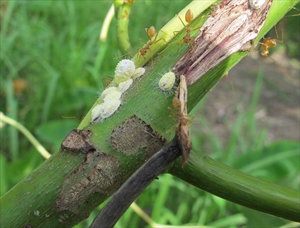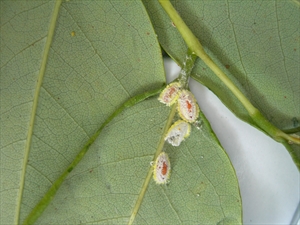Seychelles scale, silvery cushion scale, breadfruit mealybug
Pacific Pests, Pathogens and Weeds - Online edition
Pacific Pests, Pathogens & Weeds
Breadfruit (Seychelles) scale (242)
Icerya seychellarum
Asia, Africa and Oceania, with limited distribution in Europe, Central and South America, the Caribbean. Recorded from American Samoa, Australia, Fiji, French Polynesia, Kiribati, Federated States of Micronesia, Nauru, New Caledonia, New Zealand, Palau, Papua New Guinea, Samoa, Solomon Islands, Tonga, Tuvalu , and Vanuatu.
Wide, especially woody plants. Common on avocado, breadfruit, Casuarina, citrus, Ficus, guava. Hosts occur in more than 60 plant families.
The scale occurs on leaves, stems, twigs and fruit. More common on stems or on the underside of leaves near the midribs (Photos 1-3). Heavy infestations cause leaves to yellow, and young shoots to die. Honeydew is produced from feeding on the phloem; fungi grow on the honeydew blocking sunlight and making fruit unattractive.
Eggs are laid in a sac carried by the female. Females have both male and female sex organs, but can give birth to living young without mating. Males are rare, and winged. Nymphs, called crawlers, are mobile and spread the mealybug. They settle down and cover themselves in the yellow wax. However, they keep their legs, eyes and antennae, and can move around.
Ant tend colonies of Icerya seeking their honeydew. In Fiji, in recent years, infestations of Icerya have increased, and this seems to be associated with an increase of ants, especially the white-footed ant, Technomyrmex species (Photos 4&5). In the process of collecting the honey dew, the ants defend the scale insects from predators and parasitoid wasps.
In Pacific islands, heavy infestations cause leaves to yellow and fall, the death of young shoots and, sometimes, the death of plants. In general, infestations reduce plant growth.
Look for large mealybug, up to 10 mm, especially along major veins on the underside of leaves or along stems. Look for the long, fine silky hairs around the body. The body is orange-red and the legs black, covered in white or pale-yellow powdery wax. Critical identification of the mealybug requires specimens to be placed on a slide and examined under a high-power microscope.
NATURAL ENEMIES
Biological control is important as insecticides may be of little use because of the waxy covering over the mealybug. Ladybird beetles (Rodolia species) have been introduced to many countries around the world, for the control of this Icerya species, and also another species, the cottony cushion scale, Icerya purchasi, that attacks citrus. Species of the parasitic fly, Cryptochaetum, are also used to control this mealybug and other Icerya species. They lay their eggs inside scale nymphs.
See also notes on natural enemies of Icerya aegyptiaca, the breadfruit mealybug (Fact Sheet no. 184). Note also that ants may need to be removed if the natural enemies are to be effective in controlling mealybug populations.
CULTURAL CONTROL
- Prune infested stems, branches and fruits and burn them.
- Apply mulch, manure or synthetic fertilizers to assist plant vigour.
- Destroy ant nests with boiling water, without damaging the plants infested with the scale insect; without the ants, parasitoids and predators will bring about natural control of the scale insect.
- For trees, prune low branches and remove weeds to stop ants reaching leaves and fruits.
CHEMICAL CONTROL
Chemical control is usually not required as the scale is kept under control by predators and parasites. If needed, use horticultural oil (made from petroleum), white oil (made from vegetable oil), or soap solution on breadfruit infested with mealybugs (see Fact Sheet no. 56).
- White oil:
- 3 tablespoons (1/3 cup) cooking oil in 4 litres water.
- ½ teaspoon detergent soap.
- Shake well and use.
- Soap:
- Use soap (pure soap, not detergent).
- 5 tablespoons of soap in 4 litres water, OR
- 2 tablespoons of dish washing liquid in 4 litres water.
Commercial horticultural oils can also be used. White oil, soap and horticultural oil sprays work by blocking the breathing holes of insects causing suffocation and death. Spray the undersides of leaves as the oils must contact the insects. The addition of malathion is useful against scales insects. Note the following:
- A second application of soap or oils may be necessary after 3-4 weeks.
- Use synthetic pyrethroid insecticides to kill ants if they are present attracted to the honeydew; these insecticides may also be tried against scale insects, as they are likely to be effective against the crawlers - crawlers are the young active nymphs which spread infestations to new plants and/or new gardens.
____________________
When using a pesticide, always wear protective clothing and follow the instructions on the product label, such as dosage, timing of application, and pre-harvest interval. Recommendations will vary with the crop and system of cultivation. Expert advice on the most appropriate pesticides to use should always be sought from local agricultural authorities.
AUTHOR Grahame Jackson
Information from CABI (2020) Icerya seychellarum (Seychelles scale). Crop Protection Compendium. (https://www.cabi.org/cpc/datasheet/28434); MAF Plant Health & Environment Laboratory (2011) Seychelles Fluted Scale (Icerya seychellarum): PaDIL - http://www.padil.gov.au.
Produced with support from the Australian Centre for International Agricultural Research under project PC/2010/090: Strengthening integrated crop management research in the Pacific Islands in support of sustainable intensification of high-value crop production, implemented by the University of Queensland and the Secretariat of the Pacific Community.








